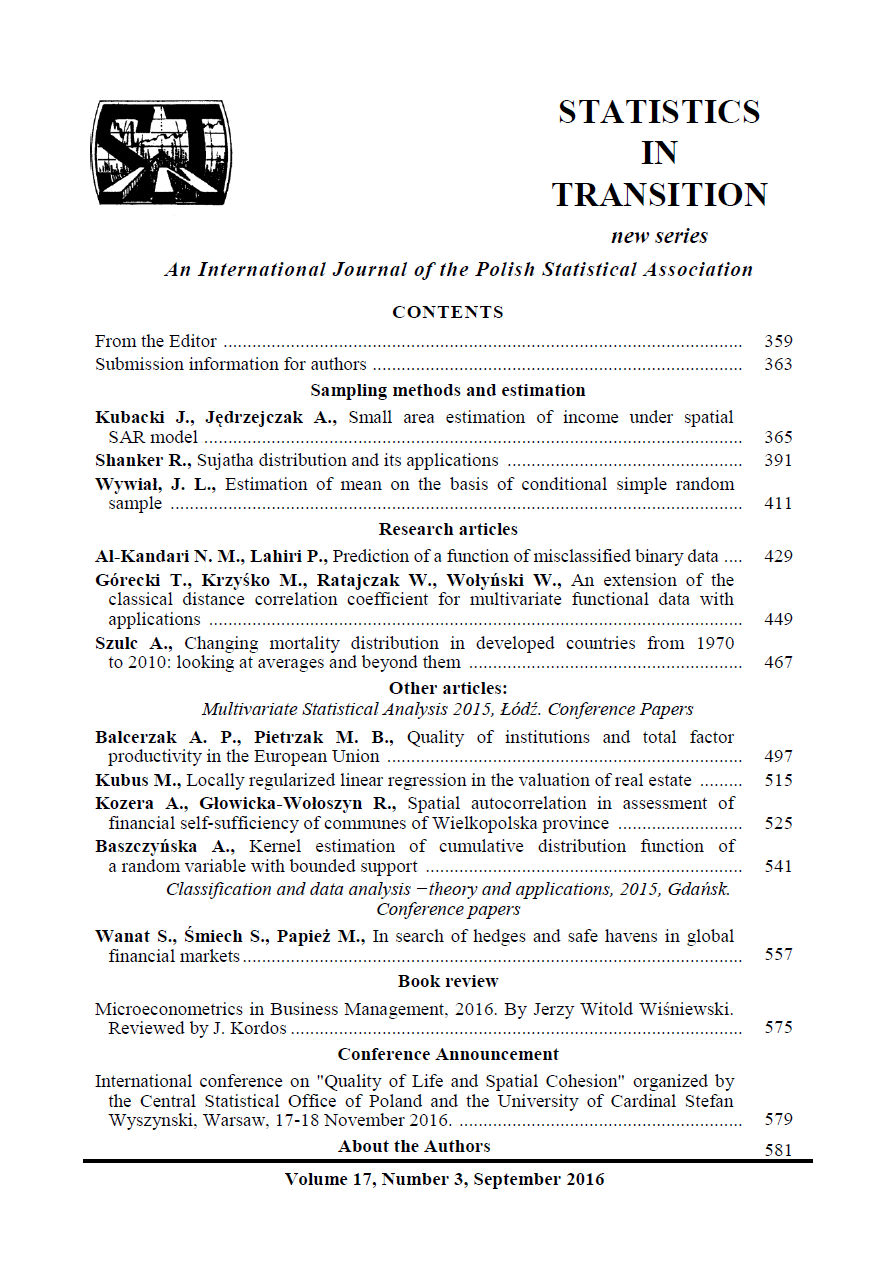ARTICLE
ABSTRACT
The aim of the paper is to search for hedges and safe havens within three instrument classes: assets (represented by the S&P500 index), gold and oil prices, and dollar exchange rates. Weekly series of returns of all the instruments from the period January 1995 – June 2015 are analysed. The study is based on conditional correlations between the instruments in different market regimes obtained with the use of copula-DCC GARCH models. It is assumed that different market regimes will be identified by statistical clustering techniques; however, only conditional variances (without conditional covariances) will be taken into account. The reason for this assumption is connected with the fact that variances can be understood as market risk, and, as such, are a good indicator of market conditions. A considerable advantage of such an approach is the lack of need to determine the number of market regimes, as it is established by clustering quality measures. What is more, the methodology used in the paper makes it possible to treat the relations between instruments symmetrically. The results obtained in the study reveal that only dollar exchange rates can be treated as a (strong) hedge and a (strong) safe haven for other instruments, while gold and oil are a hedge for assets.
KEYWORDS
market regimes, clustering methods, copula, DCC-GARCH.
REFERENCES
ALOUI, R., BEN AISSA, M. S., NGUYEN, D. K., (2013). Conditional dependence structure between oil prices and exchange rates: A copula GARCH approach. Journal of International Money and Finance, 32, pp. 719–738.
BAUR, D. G., MCDERMOTT, T. K., (2010). Is gold a safe haven? International evidence. Journal of Banking & Finance, 34(8), pp. 1886–1898.
BAUR, D. G., LUCEY, B. M., (2010). Is gold a hedge or a safe haven? An analysis of stocks, bonds and gold. Financial Review, 45(2), pp. 217–229.
BECKMANN, J., BERGER, T., CZUDAJ, R., (2015). Does gold act as a hedge or a safe haven for stocks? A smooth transition approach. Economic Modelling, 48, pp. 16–24.
CALINSKI, T., HARABASZ, J., (1974). A dendrite method for cluster analysis. Communications in Statistics, 3 (1), pp. 1–27.
CINER, C., GURDGIEV, C., LUCEY, B. M., (2013). Hedges and safe havens: An examination of stocks, bonds, gold, oil and exchange rates. International Review of Financial Analysis, 29, pp. 202–211.
DESGRAUPES, B., (2015). Clustering Indices, package ‘clusterCrit’, https://cran.r-project.org/web/packages/clusterCrit.
DOMAN, R., (2011). Zastosowanie kopuli w modelowaniu dynamiki zależności na rynkach finansowych [The use of copulas in modelling the dynamic dependence on the financial markets], Wydawnictwo Uniwersytetu Ekonomicznego w Poznaniu, Poznań.
DUNN, C. J., (1974). Well-separated clusters and optimal fuzzy partitions. Journal of Cybernetics 4, pp. 95–104.
ENGLE, R.F. AND SHEPPARD, K., (2001). Theoretical and empirical properties of dynamic conditional correlation multivariate GARCH, NBER Working Paper.
HOOD, M., MALIK, F., (2013). Is gold the best hedge and a safe haven under changing stock market volatility? Review of Financial Economics, 22 (2), pp. 47–52.
JOE, H., (1997). Multivariate models and dependence concepts. Chapman-Hall, London.
JOY, M., (2011). Gold and the US dollar: Hedge or haven? Finance Research Letters, 8 (3), pp. 120–131.
KAUFMAN, L., ROUSSEEUW, P. J., (1990). Finding Groups in Data: An Introduction to Cluster Analysis, New York: Wiley & Sons.
LEE, T.-H., LONG, X., (2009). Copula-Based Multivariate GARCH Model with Uncorrelated Dependent Errors. Journal of Econometrics, 150, pp. 207–218.
LI, M., YANG, L., (2013). Modeling the volatility of futures return in rubber and oil – A Copula-based GARCH model approach. Economic Modelling, 35, pp. 576–581.
NELSEN, R. B., (1999). An Introduction to Copulas. Springer-Verlag, New York.
NELSON, D. B., (1991). Conditional Heteroskedasticity in Asset Returns: A New Approach. Econometrica, 59, pp. 347–370.
PATTON, A. J., (2006). Modelling asymmetric exchange rate. International Economic Review, 47, pp. 527–556.
PATTON, A. J., (2012). A review of copula models for economic time series. Journal of Multivariate Analysis, 110, pp. 4–18.
REBOREDO, J. C., (2013a). Is gold a hedge or safe haven against oil price movements? Resources Policy, 38(2), pp. 130–137.
REBOREDO, J. C., (2013b). Is gold a safe haven or a hedge for the US dollar? Implications for risk management. Journal of Banking & Finance, 37(8), pp. 2665–2676.
SERBAN, M., BROCKWELL, A., LEHOCZKY, J., SRIVASTAVA, S., (2007). Modelling the Dynamic Dependence Structure in Multivariate Financial Time Series. Journal of Time Series Analysis, 28, pp. 763–782.
WALESIAK, M., DUDEK A., (2015). Searching for Optimal Clustering Procedure for a Data Set, package ‘clusterSim’, https://cran.r project.org/web/packages/clusterSim.
WANAT, S., (2012). Modele zależności w agregacji ryzyka ubezpieczyciela. [Dependence models in the aggregating of insurer risk], Wydawnictwo Uniwersytetu Ekonomicznego w Krakowie, Kraków.
WU, C. C., CHUNG, H., CHANG, Y. H., (2012). The economic value of co movement between oil price and exchange rate using copula-based GARCH models. Energy Economics, 34, pp. 270–282.
ZOLOTKO, M., OKHRIN, O., (2014). Modelling the general dependence between commodity forward curves. Energy Economics, 43, pp. 284–296.
XIE, X., BENI, G., (1991). Validity measure for fuzzy clustering. IEEE Transactions on Pattern Analysis and Machine Intelligence, 13, pp. 841–847
